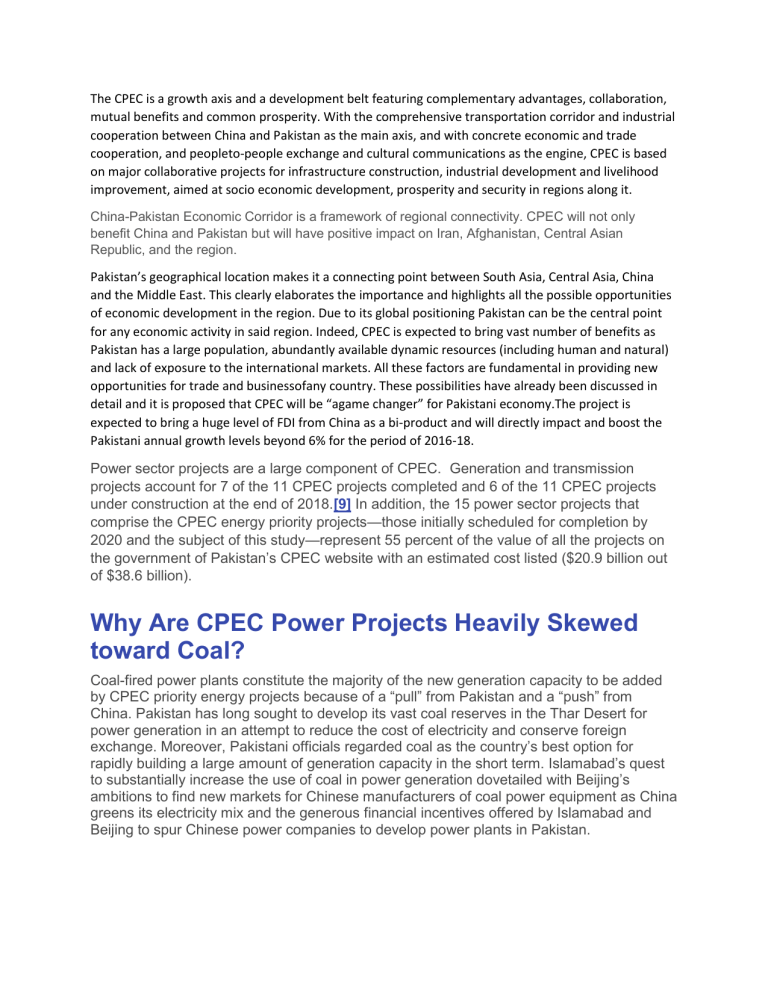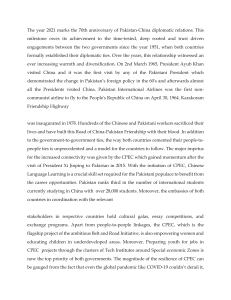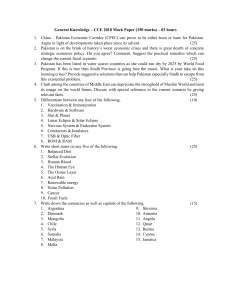
The CPEC is a growth axis and a development belt featuring complementary advantages, collaboration, mutual benefits and common prosperity. With the comprehensive transportation corridor and industrial cooperation between China and Pakistan as the main axis, and with concrete economic and trade cooperation, and peopleto-people exchange and cultural communications as the engine, CPEC is based on major collaborative projects for infrastructure construction, industrial development and livelihood improvement, aimed at socio economic development, prosperity and security in regions along it. China-Pakistan Economic Corridor is a framework of regional connectivity. CPEC will not only benefit China and Pakistan but will have positive impact on Iran, Afghanistan, Central Asian Republic, and the region. Pakistan’s geographical location makes it a connecting point between South Asia, Central Asia, China and the Middle East. This clearly elaborates the importance and highlights all the possible opportunities of economic development in the region. Due to its global positioning Pakistan can be the central point for any economic activity in said region. Indeed, CPEC is expected to bring vast number of benefits as Pakistan has a large population, abundantly available dynamic resources (including human and natural) and lack of exposure to the international markets. All these factors are fundamental in providing new opportunities for trade and businessofany country. These possibilities have already been discussed in detail and it is proposed that CPEC will be “agame changer” for Pakistani economy.The project is expected to bring a huge level of FDI from China as a bi-product and will directly impact and boost the Pakistani annual growth levels beyond 6% for the period of 2016-18. Power sector projects are a large component of CPEC. Generation and transmission projects account for 7 of the 11 CPEC projects completed and 6 of the 11 CPEC projects under construction at the end of 2018.[9] In addition, the 15 power sector projects that comprise the CPEC energy priority projects—those initially scheduled for completion by 2020 and the subject of this study—represent 55 percent of the value of all the projects on the government of Pakistan’s CPEC website with an estimated cost listed ($20.9 billion out of $38.6 billion). Why Are CPEC Power Projects Heavily Skewed toward Coal? Coal-fired power plants constitute the majority of the new generation capacity to be added by CPEC priority energy projects because of a “pull” from Pakistan and a “push” from China. Pakistan has long sought to develop its vast coal reserves in the Thar Desert for power generation in an attempt to reduce the cost of electricity and conserve foreign exchange. Moreover, Pakistani officials regarded coal as the country’s best option for rapidly building a large amount of generation capacity in the short term. Islamabad’s quest to substantially increase the use of coal in power generation dovetailed with Beijing’s ambitions to find new markets for Chinese manufacturers of coal power equipment as China greens its electricity mix and the generous financial incentives offered by Islamabad and Beijing to spur Chinese power companies to develop power plants in Pakistan. There will also be indirect economic impacts that are likely to be much larger than initially expected.Intriguingly, this proposition is supported by the available data and both contributing partners,Pakistan and Chinaare expected to gain substantial benefits from this initiative.14 Adding to the benefits of CPEC, the most significant benefit for Pakistan will be in power generation sector. Pakistan has been through severe energy crisis in past decade, which resulted in significant and continues decrease in industry, low levels of FDIs, inappropriate infrastructural development, reduced self-dependency due to increasing import levels and terrorism.15It is a crucial step towards updating and enhancing the underdeveloped infrastructure of the country by an in pour of $11 million investment. This amount will be utilized for the development of new roads, railway network and also for the upgrade of existing infrastructure. As well-developed transport infrastructure is required for the efficient inter- and intra-regional communication, this subproject of CPEC will improve the efficient communications and transport connectivity among all four provinces of Pakistan. Nearly 75 percent of the generation capacity of CPEC power plants is coal-fired. Pakistan’s National Electric Power Regulatory Authority (NEPRA) expects that CPEC coal power plants will be largely responsible for the projected increase in the country’s coal-fired generation capacity from 3 percent as of June 30, 2017 (fewer than six months after the first CPEC coal plant began commercial operation), to 20 percent in 2025. The growing list of CPEC benefits also includes the setup of specialized economic zones. Such economic zones promote new entrepreneurial activity and also initiate the inception of new enterprises within a pre-selected geographical area. Further, these economic zones will be equipped with state of the art facilities. As a CPEC subproject, initially, 9specialized economic zones are to be developed that are expected to boost up struggling economy of the country by providing new opportunities especially for the local communities of underdeveloped areas across Pakistan, e.g. KPK and Baluchistan will be the biggest beneficiaries of this subproject.17 In these provinces, main focus of specialized economic zones will be on the industries like food, pharmaceuticals, engineering, auto and food packaging.18In addition, Baluchistan will also reap benefits of these centers of the economic activity at locations like Gwadar, Lasbela, Turbat, Dera Murad Jamali, Bostan etc. Further, Sindh province will also get its fair share by setting up of industrial parks at Karachi & Port Qasim.19 As the aim of these specialized economic zones development is to improve the industrial production in order to increase the country’s exports.This will not only have a positive impact on the domestic economic conditions but will also accommodate large scale industrialization within the region.20The future implications of projects associated with CPEC initiative will be a success factor for the social welfare in terms of employment generation and better economic, health and education opportunities for the local populations of Pakistan who will be the direct beneficiaries of the associated benefits. This will not only enhance connection among all four provincesof the country andwill also generate employment opportunities for native population. Further, average household income levels are estimated to rise 5.21% approx. by 2020.21. Along with all its positive aspects, CPEC initiative may have few challengesassociated with it. environmental sustainability and debt sustainability. Concerns about environmental sustainability center on the ways in which an expansion of the amount of electricity generated globally by fossil fuels, especially coal, will increase greenhouse gas emissions, making it more difficult if not impossible to meet the emissions targets in the Paris Agreement. Concerns about debt sustainability focus on whether China’s lending in support of infrastructure projects will lead to problematic increases in debt, with some analysts maintaining that Beijing is intentionally seeking to push countries into debt distress in an attempt to gain control over strategic assets or decision-making in borrowing countries.The most talked about and significant issue that has been the matter of discussion for experts is the actual terms of the loan that Chinese government and banks have and will lend for the mega project over the specified time period. Empirical evidence based on existing research work has shown that similar debt services to the extent of the debt associated CPEC had previously impacted the Pakistan’s Gross Private Capital Investment in negative manner. After four years of Phase I of CPEC, Pakistan is now ready to enter Phase II. Some 27 projects are planned within the framework of Phase II. This phase emphasizes industrial cooperation, agricultural development and trade promotion. Does Pakistan have enough soft infrastructure to attract investments in the industrial sector, especially in the special economic zones (SEZs)? It is clear that Pakistan may not have developed the fundamentals needed to realize all the benefits of Phase II of CPEC.There are three prerequisites that are needed to reap the potential benefits of industrialization and tourism: human capital (HC), rural connectivity (RC) and a business environment (BE) that will attract foreign direct investment (FDI) and tourists. The current status of these prerequisites is poor. Another aspect highlights the possibilities of before and after CPEC implications may include Chinese state owned enterprise contracts within Pakistan who may have limited rights to the endproduct of the project.23Intriguingly, the financial aspect of CPEC has now entered another avenue as authorities from both countries have recently agreed on settling the trade in local currency, Pak rupees or Chinese Yuan. This could be of advantage as traders will not have to pay extra conversion costs for USD. On the other hand, according to experts this currency swap is actually a step forward for globalization of Chinese yuan. However, it is still not clear that how exactly this currency swap proposal will be effected and how the shortage of yuan in local foreign exchange markets will be overcome.24 Further, ongoing war on terror and unpredictable security situation of Pakistan has also increased the project liability forcountry’s economy. The most important factor associated with CPEC for Pakistan is international pressures by its western allies who are already in competition with china in the global markets. Moreover, Pakistan’s long-term counterpart USA also explicatedsome reservations. Efforts to obstruct the initiative from going ahead by Pakistan’s traditional oppose, India, who is also a mutual enemy of China is and can be a challenge.Strategically, Pak-China collaboration is of major concern for India with reference to Afghanistan, where Chinese circle of concern is much wider than just economic interests e.g. China has beenactively involved in facilitating Taliban-Afghan government dialogue for peace. Previously this role was supposed to be taken by India who posed to be amajor player in the region. Indian hostility towards the CPEC initiative is also due to the fact that China has formally accepted Pakistan’s stance on the Kashmir issue and has shown full commitment and support to the Pakistani cause.25 In terms of regional stability of the south-Asian region, previously USA considered Pakistan as a non-NATO ally and India as a friendly country. Due to Pak-China growing relations in economic and defense sector that perception has shifted, US now consider India as an ally and Pakistan as a threat. This shift in the US foreign policy can create problems like stoppage to economic and political supportfor Pakistan in coming future.26In addition internal provincial reservations from KPK, Baluchistan and Sindh also pose a threat to timely and successful completion of the project. The successful completion of CPECproject is achallenge to deal with by Pakistan’s federal government due to a number of grievances especially from the provinces of Baluchistan and KPK. Due to all aforementioned reasons and sensitive nature of the regional, cultural and political differences,achieving the project completion deadline of 2030 as per MoU, seems an uphill task to be achieved.27 On the one hand China is closing their own coal based power plants in view of degradation of the environment while on the other is transferring the same to Pakistan in complete disregard to the international standards regarding environment. “Though the Hydroelectricity is cheaper but it needs lot of time to build. To solve Power Generation problem as fast as possible, Pakistan don’t have any choice but to accept Coal based plants which later become major problems for Pakistani Environment”.28The question is why the Pakistani setup has allowed it to occur? It may also have drastic impact on the environment of the region. China’s track record of noncompliance to international Environmental laws and their involvement in related issues may bring utter destruction of ecological systems in the areas it may operate.29Pakistani authorities need to ensure that the local environment must not be manipulated. According to a report by International Union for Conservation of Nature (IUCN), roughly 54,000 trees have been cut down for the construction of CPEC infrastructure in KPK in various associated sub-projects. This is destroying the ecosystem in the region and the infrastructure development and coal-energy generation projects will increase the Greenhouse gas (GHG) emission straining the local volatile environments. This is threat for climate change and agriculture sector and the current rise in temperatures and shortened winter weather is a sign of the problem. This is assumed that the productivity of the agriculture sector will be reduced. It reveals that environment impact assessment (EIA) has not been done before the inception of CPEC. Despite the assurance from China-Pakistan Governments many doubts about the positive effects of CPEC have been raised. Lack of transparency, vague term of investments and heavy lending terms from china and over all red-tapeism culture has made it quite controversial.





